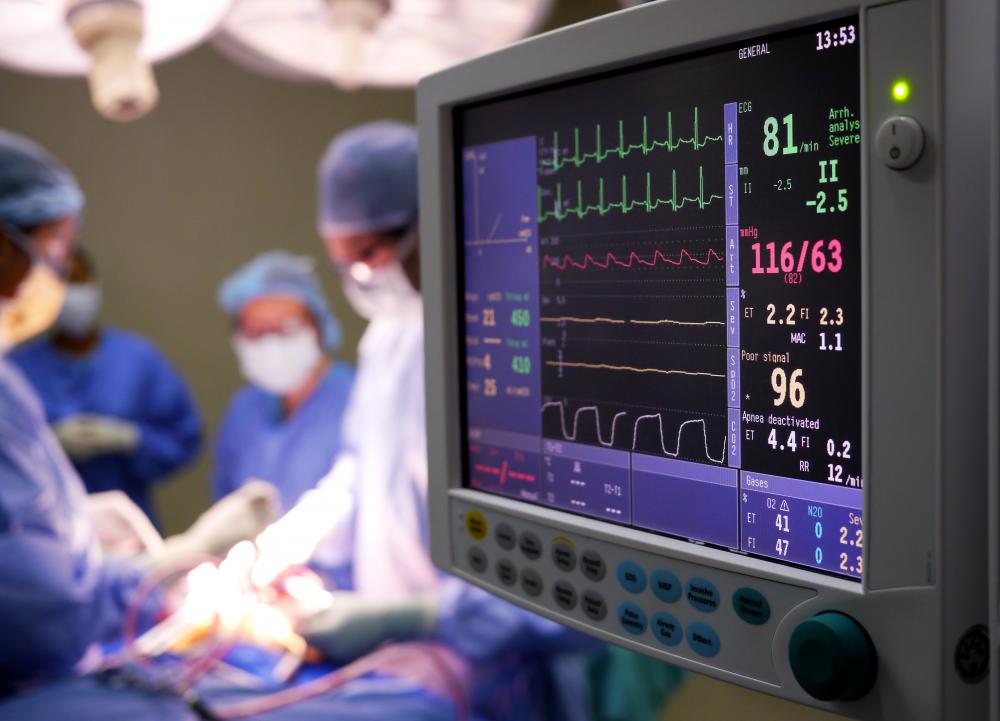At TheHealthBoard, we're committed to delivering accurate, trustworthy information. Our expert-authored content is rigorously fact-checked and sourced from credible authorities. Discover how we uphold the highest standards in providing you with reliable knowledge.
What is Anesthesia?
Anesthesia is used in surgery to minimize pain, discomfort, and shock for surgical patients. There are several types that can be used depending on the needs of the surgery: general, local, regional, and conscious sedation. When anesthesia works as expected, the patient feels no pain during a procedure, and often does not remember the proceedings either. It increases patient comfort, which can in turn reduce recovery times. With the knowledge that they are not inflicting pain, it also makes it easier for a medical staff to work.
When anesthesia comes to mind, most people think of general anesthesia. This type is a complete loss of consciousness in the patient accomplished through a combination of injected and inhaled drugs. It is often used for highly invasive surgeries, or cases when total relaxation of the patient is required. General anesthesia carries the most surgical risk because of the state of complete unconsciousness. As a result, the anesthesiologist will manage the patient carefully throughout surgery.

The exact mechanism through which general anesthesia works is unclear. It is believed that the anesthetics act on the brain to produce unconsciousness, and on the nerves and spinal cord to promote immobility and reduce pain. This type is maintained through carefully monitored administration of additional inhaled drugs throughout the surgery.
Local anesthesia involves injected drugs which numb a small area. Many patients have experienced a local anesthetic in the form of Novocaine, which is used in dental applications. Local anesthetics are used when the patient would feel pain, but doesn't need to be unconscious. Any small, localized procedure such as setting stitches is suitable for the local type.

Regional anesthesia is similar to local, except that it covers a wider area of the body. It works by blocking nerve impulses, and is often used during labor and delivery in the form of an epidural. Sometimes, regional anesthesia is used for long term pain management in individuals who experience chronic lower body pain. It allows doctors to block sensations to the entire lower body, or single limbs.

Conscious sedation is an anesthesia practice where the patient remains conscious, but is fully relaxed, does not feel pain, and will not usually remember the experience. This type is useful in situations where patients need to cooperate with medical staff, or when a procedure is not serious enough to warrant putting them to sleep. In cases where a patient is not stable enough for general anesthesia, conscious sedation may be used.

Anesthesia is a vital part of surgical practice, allowing doctors to operate safely and painlessly on patients. The wide variety of anesthetics available allows anesthesiologists to select the most suitable type and anesthetic drug for the patient. Many people will experience some form during their lifetime, and will appreciate the lack of pain associated with it.
AS FEATURED ON:
AS FEATURED ON:















Discussion Comments
In two elderly family members, I have observed a behavior which seems like the "hospital psychosis" described on this site, but was definitely associated with anesthesia (a bypass operation in one case and spinal surgery in the other).
Doctors told me that this condition is more common in relatively uneducated patients (both left school at about 16 in order to work). Can you provide more information? there may be another spinal operation in the near future.
I am very suspicious of general anesthesia, and really would prefer not to have to get it done. While it is commonly used, there are just a lot of possible risks and complications. So far I have only needed local anesthetic, which frightens me much less.
@anoon141651, it depends on a lot of factors, including a person's age, size, overall health, and where he or she is receiving anesthesia. While many people can "go under" with no problem, some people can have serious anesthesia complications, and it is very hard sometimes to determine why.
Has anybody ever been under anesthesia, but still aware? I remember when I had my second child I had a C-section, and they put me part of the way under, but I could still feel the surgeons making the incision.
It didn't hurt or anything, but it was so unreal! Apparently this is pretty normal (at least that's what my anesthesiologist told me afterwards) since they don't want the mothers to be fully out of it for the safety of the baby.
Did anybody else get the same thing with their C-section?
@anon141651-- It usually depends on the person as far as how long anesthesia works in the body. If a person is larger, the anesthesia administered can wear off faster than if the person is smaller. It's up to the Anesthesiologist to monitor the patient closely while they are under.
How long will each anesthesia work in the body?
Post your comments